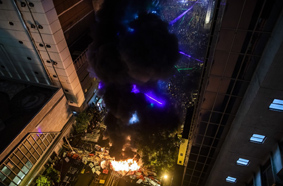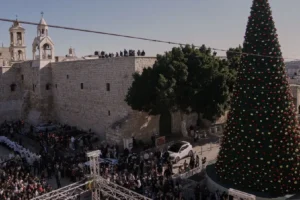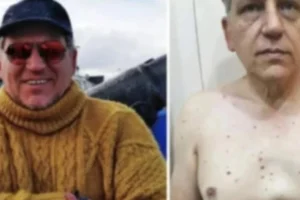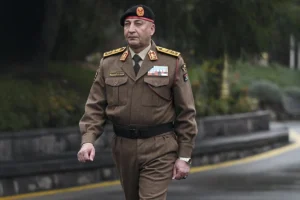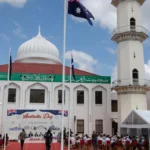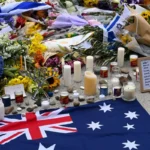
Hong Kong’s anti-government protesters have sustained their momentum for more than three months, facing off against police through summer heat and clouds of tear gas.
Officers have met demonstrators head on with a variety of tactics, which they tally following most major events.
Sept. 15: MTR fires and tear gas before dark
After nearly 100 days of unrest, both demonstrators and police appeared to get more aggressive earlier in the day compared to the previous 14 weekends of protests. Defying a police ban, tens of thousands of protesters streamed from Causeway Bay to Central, disrupting traffic and prompting major stores to close. Demonstrators set fire to entrances to Wanchai MTR station before dark, while others threw petrol bombs at the central government headquarters in Admiralty. Riot police used tear gas, water cannons, blue dye and pepper spray to clear the crowds. Elsewhere in Hong Kong, police broke up multiple clashes throughout the weekend between pro-democracy and pro-Beijing demonstrators. Separately, an opposition lawmaker was arrested, and the first demonstrator to be sentenced was ordered to 80 hours of community service by a Hong Kong court on Friday.
Sept. 9: Students form human chains
Students and demonstrators held hands to form human chains, chanting “Add oil!” and singing “Do You Hear The People Sing” in the early morning before classes began. Chains formed near various schools on both sides of the harbor, including in Midlevels—the first protest in this quiet and hilly neighborhood popular with expats.
Sept. 8: Clashes escalate around MTR stations
Police fired tear gas at protesters who built barricades, started blazes and paralyzed traffic in prime business areas, as activists sought to show they weren’t satisfied with Carrie Lam’s concessions. Some demonstrators set a fire at an entrance to the Central subway station, one of the city’s busiest transit hubs, before scattering to other districts. Earlier, tens of thousands marched peacefully to the U.S. consulate to solicit American support, after filling up a park the size of a football field and stretching for blocks in every direction. Separately, prominent activist Joshua Wong was detained at the airport on suspicion of breaching his bail terms, delaying his planned trip to the U.S. and Germany, only to be later released by a judge who blamed a document error.
The incidents capped a weekend which also saw police fire tear gas in Mong Kok—one of Hong Kong’s most densely populated areas—after protesters angry over recent police actions in train stations dismantled railings and traffic lights and started fires. By Saturday morning, MTR Corp. said it shut down several major airport rail stations, while groups of people staged sit-ins at malls near train stations. The Hong Kong Journalists Association condemned the police use of pepper spray on a group of reporters while clearing the streets.
Sept. 2: Student boycott begins
Many students at universities and secondary schools across Hong Kong started the new academic year by going on strike—holding rallies at Edinburgh Place, the Legislative Council complex and Chinese University of Hong Kong. The demonstrations marked the beginning of two weeks of boycotts and rallies planned by student groups. Medical workers at Queen Mary Hospital held their own demonstration in the hospital halls denouncing recent violence. Earlier in the morning, riot police patrolled several MTR stations where protesters had planned to disrupt train service and arrested 8 people for violating an MTR injunction and possessing weapons. Hong Kong’s No. 2 official, Matthew Cheung, told reporters the government wouldn’t rule out invoking an emergency law to help police contain the protests.
Sept. 1: Airport disrupted, rare police searches at Central piers
Protesters disrupted transport to and from the Hong Kong International Airport following a night of violence in the city. They built barricades to block the freeway, vandalized turnstiles and damaged equipment at train stations. The Airport Express train services were suspended, as well as nearby Tung Chung and Disneyland Resort lines. As riot police cleared the protest, and with transport services suspended, the crowd was forced to walk from the airport to the nearest train station which is around 17 kilometers away. Some opted to take the ferry from Mui Wo and Discovery Bay in Lantau Island, only to be surprised by riot police waiting for them at the Central ferry piers. Thorough searches were made but there were no arrests at the pier, according to the police.
Aug. 31: Petrol bombs & water cannons
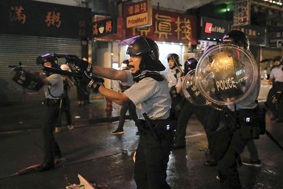
Tens of thousands of people defied authorities to join an unauthorized march that began peacefully but descended into violence later in the day in the 13th week of pro-democracy protests. Crowds gathered in various neighborhoods, with police setting up barricades in Sai Ying Pun to protect the main Chinese government office in the city. Clashes broke out in the afternoon and continued through the evening with police firing tear gas and showering protesters with blue dye from water cannons. Protesters set fires, threw Molotov cocktails and hurled bricks at police. Police fired two live rounds into the air. The violence spilled into the city’s metro system, with clashes reported in various stations and images of bloodied protesters and passengers circulating on social media. Service was suspended on at least two key lines.
Aug. 27: 80 days of unrest
The movement continued into its 80th day, outlasting the Occupy movement in 2014, when pro-democracy protesters occupied swaths of the city and major thoroughfares for a total of 79 days.
As protesters’ demands evolve to reflect wider dissatisfaction with the government, the popularity rating of Hong Kong Chief Executive Carrie Lam has slumped to the lowest level since she took office, making her the city’s least popular leader ever, according to the Hong Kong Public Opinion Program survey released Tuesday. People’s confidence in “One Country, Two Systems” also fell to lowest since record began in 1993, the survey showed.
Aug. 23: Thousands Form Human Chain Across City
Thousands of protesters lined the streets of Hong Kong, holding hands to form a human chain across the city. Some yelled, “Fight for freedom. Stand with Hong Kong.” A group headed up to the iconic Lion Rock peak, while others took to tourist hotspots and the business district. The demonstration was inspired by the 30th anniversary of the Baltic Way, when about 2 million people in the countries now known as Estonia, Latvia and Lithuania formed a human chain stretching 676 kilometers.
August 18: Protesters Reset Movement With Peaceful March
Protesters braved an afternoon of pouring rain to march peacefully from Victoria Park, as the movement’s more moderate leaders sought a reset after violent scenes at the city’s airport earlier in the week. “When we make mistakes, we do admit it. We apologize. We promise to do better next time, which is exactly contrary to our government,” said Wong Yik-mo, vice convener of the Civil Human Rights Front, which organized the rally. CHRF said more than 1.7 million people attended, while police put the turnout at a more conservative 128,000.
August 12: Airport Shutdown
Airport authorities canceled all remaining flights in the afternoon after thousands of black-shirted protesters unexpectedly descended on the main terminal for a fourth straight day, fueled by anger with police. They sat on the ground of the arrivals hall, crippling the airport and eventually leaving thousands of travelers stranded. Shares of the city’s main airline Cathay Pacific Airways Ltd. tumbled to a 10-year low on the news.
August 7: China Calls Urgent Meeting
China’s top officials overseeing Hong Kong affairs convened a meeting just across the border in Shenzhen as fears mounted that Beijing would mobilize forces to quell the unrest. Zhang Xiaoming, director of the Hong Kong and Macau Affairs Office, rejected an independent inquiry into the unrest—a key demand of the protesters that also had support from business leaders.
August 5: Strike Snarls City
People chanting “Strike!” fanned out across Hong Kong, disrupting the morning rush-hour commute and leaving traffic jammed, subway lines inoperable and more than 170 flights canceled. At afternoon rallies, police fired tear gas to disperse crowds while violence broke out in some areas between residents and demonstrators. “I could even dare to say some are trying to ruin Hong Kong and completely destroy the livelihood of seven million citizens,” Lam said.
July 27: Protesters “Take Back” Yuen Long
Thousands of black-shirted protesters gathered in Yuen Long to march in opposition to the violent attacks that happened there a week earlier, when men wearing white shirts stormed the train station and brutally beat people with sticks. The night ended in more violence at the Yuen Long MTR station. Police fired tear gas and high-pressured water at protesters, and pinned some to the ground to make arrests.
July 1: Protesters Trash Legislature
While demonstrations marking the 22nd anniversary of Hong Kong’s return to China stayed largely peaceful, a militant group of demonstrators wearing hard hats stormed the city’s legislature in the evening. Using a metal cart as a battering ram, protesters smashed through a glass entryway as riot police huddled inside and shot rounds of tear gas. Demonstrators pulled down portraits, spray-painted slogans and draped a Union Jack-emblazoned colonial flag across the president’s desk.
June 26: Protesters Call for International Help Ahead of G-20
Protesters looked to keep their complaints on the global agenda with demonstrations ahead of Chinese President Xi Jinping’s attendance at the Group of 20 summit in Japan. They delivered letters to local G-20 consulates urging intervention against the bill before gathering downtown. Demonstrators chanted slogans such as “Free Hong Kong, democracy now!” in the languages of G-20 countries including German, French and Korean. Afterwards, hundreds of people walked to police headquarters in nearby Wan Chai and protested for hours in front of the building.
June 16: Hong Kong’s Largest March Ever
As many as 2 million people took to the streets in Hong Kong’s largest protest turnout ever, a day after Lam suspended work on—but didn’t withdraw—the extradition bill. The march started in Victoria Park and ended at the Legislative Council in Admiralty. Protesters called for the complete withdrawal of the legislation as well as the embattled chief executive’s resignation, leading her to apologize publicly via a statement.
June 12: Protesters Block Debate on Bill
After the historic march on June 9, Lam announced that the controversial bill would continue to a second reading, during which the legislative council could consider further amendments to quell public anger. In response, thousands of black-shirted protesters gathered around the Hong Kong Legislative Council building to prevent lawmakers from gathering to debate the bill further. Police fired tear gas, rubber bullets and bean-bag rounds at charging demonstrators, who flung bricks, metal poles and other objects at the officers. At least 72 people were injured. Police Commissioner Stephen Lo said the use of force was justified to control a “riot situation,” infuriating the opposition.
June 9: Historic March Kicks Off Protests
Hundreds of thousands of demonstrators marched from Victoria Park to Admiralty, home to the government’s headquarters, to express their dismay with the proposed extradition bill. It was one of Hong Kong’s largest protests since returning to Chinese rule in 1997. Demonstrators sought to block roads around the Legislative Council complex, a tactic used in the 2014 protests. Skirmishes broke out after dark, and riot police used pepper spray and batons to disperse violent demonstrators who attacked them.
June 4: Annual Vigil for Tiananmen Square Massacre
Tens of thousands gathered in Victoria Park to commemorate the 30th anniversary of the Chinese military’s bloody crackdown on student-led protests in Beijing. Commemorating June 4, 1989 is forbidden on the mainland, where the government has scrubbed the events from history books and the Internet.
“Hong Kong is a very free society,” Lam said. “If there are public gatherings to express their views and feelings on a particular historic event, we fully respect those views.”
May 31: Government Amends Bill Again
The government introduced further amendments, saying extradition would apply to crimes that carry a maximum sentence of seven years in prison. Raising that threshold removes other categories of crimes from the proposed law, including criminal intimidation, giving firearms to unlicensed persons and some sexual crimes.
April 28: Tens of Thousands Protest
Lam vowed to press forward with the bill’s passage despite some of the city’s largest mass protests since the 2014 Occupy movement. Organizers said up to 130,000 demonstrators marched to the legislature, many calling for her to step down. Police say fewer than 23,000 attended.
April 3: Legislation Submitted
The government introduced its proposed bill to the Legislative Council with a goal to pass it before the session ends in July.
March 27: Extradition Bill Scaled Back
Facing a public backlash, authorities scaled back the proposal, removing nine categories of financial crimes—including bankruptcy, securities and futures, and intellectual property. The concessions did little to silence discontent: The bill still covered offenses including murder, polygamy and robbery, which are all eligible for at least a three-year jail sentence under existing laws.
February 12: Proposal to Allow Extradition to China Introduced
Lam’s government proposed legal changes to allow the transfer of criminal suspects between jurisdictions with which it lacks formal extradition agreements—including mainland China. Activists, lawyers and members of the business community warned that exposing Hong Kong residents to China’s legal system could risk the city’s autonomy and status as a financial hub.
(Note: A previous version of this story included a tally of days with protest activity and a tally of protesters arrested. This has been substituted with the number of days since protests became widespread on June 9 and the number of protest-related arrests, respectively.)
Source: bloomberg.com
The views expressed in this article are solely those of the author and do not necessarily reflect the opinions of TA NEA NEWSPAPER AND 3XY RADIO.


